
It’s hard to overlook HTC’s numerous problems and financial shortcomings of the past year. The Facebook Home-laden First didn’t sell; the company suffered a management exodus; and some people still can’t get over that inexplicable Robert Downey Jr. commercial. It really is a shame the company has fallen on hard times, because it’s capable of making truly great products.
Case in point: the new HTC One (M8), which is now the best Android phone on the market.
The One is HTC’s second attempt at a super-premium Android phone, and
it’s even more impressive than its predecessor. It’s beautiful,
battery-efficient, and fueled by all the latest components—and that
UltraPixel camera still excels in areas where other camera phones have
fallen short.
We really, really like it.
Hey there, good lookin’
 Michael Homnick
Michael Homnick
HTC has done it again: It’s managed to bring panache to an otherwise
uninspired market of Android devices. The company’s executives have
taken numerous digs at its competitors’ plastic-y phones, and for good
reason—they’re more prone to cracking while the HTC One is essentially a
tank, due in part to the fact that 90 percent of its chassis is metal.
While it’s certainly not impenetrable, it is one of the most polished
Android devices out there. HTC chose a smooth aluminum finish that
doesn’t feel scratchy to the touch, and it feels great in the hand. In
the Android market, nobody has come close to HTC’s industrial design or
build quality.
 Michael Homnick
Michael Homnick
The power button on the second-generation HTC One has been moved from
the top-left to the top-right, while the volume buttons remain on the
right side. You’ll also notice there are pinholes on both the left and
right sides of the device that pop out to reveal the nanoSIM and MicroSD
card trays.
As a result, the One is only available in 16GB and 32GB variants, since
it now features expandable storage—a feature that consumers wanted in
the original One, even though Android 4.4 KitKat isn’t exactly friendly to SD cards. In the U.S. market, most carriers are defaulting to the 32GB version, a nice bump from entry-level 16GB phones.
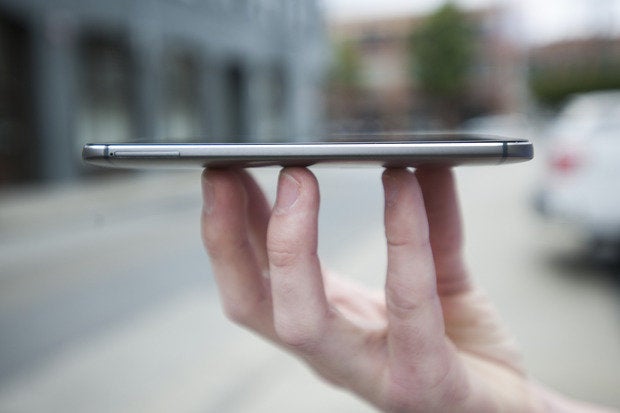 Michael Homnick
Michael Homnick
HTC kept the charging port on the bottom, but placed the headphone jack
next to it. This becomes a slight inconvenience if you’re watching a
video or listening to music with headphones on while it’s charging. The
One also supports QuickCharge 2.0, but curiously comes boxed with a
QuickCharge 1.0 charger, so you’ll have to purchase a new charging
mechanism to take advantage of that particular feature.
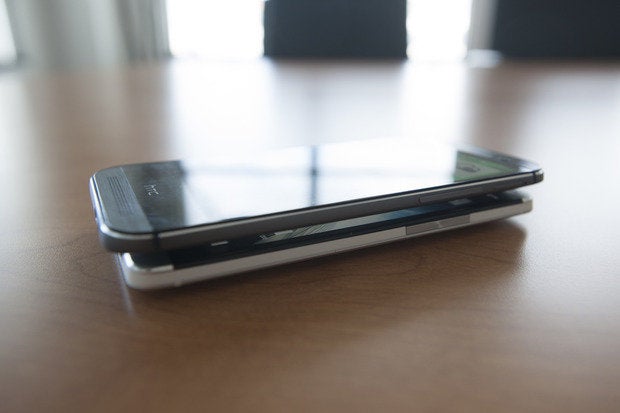 Michael Homnick
Michael Homnick
The One (M8) is less than half an inch longer and about 5 mm thicker
than its predecessor. Though I vehemently prefer smaller phones because
of my relatively small hands, I didn’t find the size of the HTC One (M8)
overpowering—especially not like its sibling, the One Max.
However, I did suffer the occasional unintended palm tap when I was
holding the device with two hands. It’s also one of the heaviest phones
I’ve handled in a while, but that’s expected with its metal chassis.
 Michael Homnick
Michael Homnick
HTC got rid of the old two-hardware-button setup and opted for three
software buttons instead. While it does steal a bit of screen space from
the One’s 5-inch display, the new setup ensures that the device will
always be up to date with Android’s button standards. Still, there’s an
awful lot of unused bezel beneath the screen.
 Michael Homnick
Michael Homnick A display like any other
HTC beefed up almost everything about its new flagship handset, except
for the screen. It’s essentially the same Super LCD 3 display panel, but
.03 inches bigger (therefore providing fewer pixels-per-inch). Its
viewing angles are perfectly acceptable for watching a YouTube flick
with a friend because there’s no color or contrast deterioration, and at
full brightness, you can see the screen outdoors just a bit more
clearly than some Super AMOLED displays.
 Michael Homnick
Michael Homnick
The HTC One’s color profile looks slightly washed-out when compared to
other current Android devices. At full brightness, the One’s blacks
aren’t nearly as black as on the Note 3’s Super AMOLED, but that’s to be
expected with the LCD 3 displays. At least its colors aren’t as
saturated as the Galaxy Note 3’s.
An iron horse
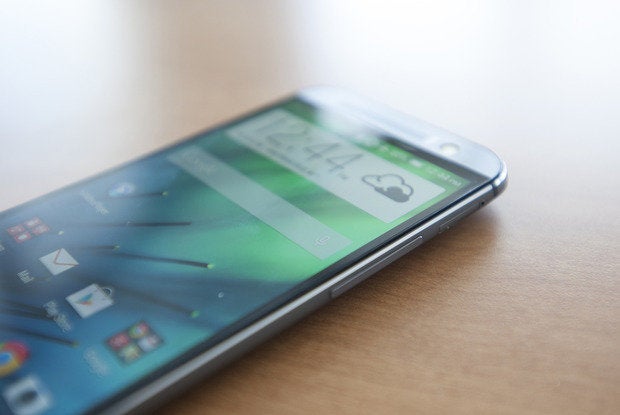 Michael Homnick
Michael Homnick
The HTC One is powered by a 2.3GHz quad-core Qualcomm Snapdragon 801
processor and 2GB of RAM. It’s the first phone in the US available with
that particular system-on-chip (SoC) and though its no-lag,
easy-to-multitask performance feels like a breath of fresh air, it’s the
energy efficiency of the processor that’s especially alluring.
HTC has repeatedly played up the fact that its integrated 2,600mAh
battery pack is a power saver, and they weren’t kidding. It lasted
through two days of varying usage without needing a charge, and it’s
almost as if it goes dormant on standby. The HTC One also managed
exactly 10 hours of constant video playback in airplane mode. That’s
half an hour longer than LG’s G2,
but an hour less than the Galaxy Note 3. Both of those devices are
larger, and have 3,200 and 3,000 mAh battery packs, respectively.
It’s impressive that HTC managed that much battery life out of a
significantly smaller battery pack. You can also take advantage of the
One’s Extreme Power Saving mode, which reverts the One to a simplified
interface and disables background services once the phone’s battery
level gets too low. U.S. carriers are still approving the software
update that includes the Extreme Power Saving mode, so early adopters
will have to be satisfied with a less aggressive, less “Extreme” regular
Power Saving mode.
 Michael Homnick
Michael Homnick
On Verizon, the HTC One had stellar call quality. It also comes standard
with dual-band 802.11a/a/c/b/g/n Wi-Fi and Bluetooth 4.0, as well NFC,
Tap & pay abilities, and a heaping of “Smart Sensors.” While sensors
are typical to most smartphones—accelerometers, gyroscopes, proximity
sensors, that sort of thing—HTC has incorporated low-power, always-on
sensors and opened them up to developers through the Smart Sensor Hub.
Currently, only a small number of apps utilize them—one is FitBit, which
lets you track your steps with MobileTrack without having to purchase
the wristband.
Low-powered sensors do seem to be all the rage lately, but it’s too
early to determine whether they’re a useful addition or a marketing
gimmick on the One. We’ll explore these after more app developers come
out in support of the Smart Sensor APIs.
Pump up the jams
 Michael Homnick
Michael Homnick
Last year, the HTC One boasted its Beats Audio sounds, but since HTC sold back its rights to
the franchise, the One now features HTC’s own BoomSound speakers. No
matter: the sound quality is still impressive, whether you’re listening
to music or perusing YouTube. HTC kept the speakers on the front so that
you don’t have to lay the phone face down when you want to pump up the
jams, and you won’t accidentally cover up a speaker when you’re holding
it, either.
The One also comes equipped with a better amp than its older sibling,
and the bass becomes more noticeable the higher you turn up the volume. I
was especially impressed at how loud the volume got when I hooked up a
mini smartphone amplifier to it. The difference is discernible even
while streaming low quality tunes through Spotify.
Camera
 Michael Homnick
Michael Homnick
Just as speculated, the HTC One has not one, but two rear-facing
cameras. But before you start thinking you’ve got yourself a deal,
consider that the extra camera doesn’t actually do much to make your
photos look better, pixel for pixel. It’s just there to help with the
One’s fancy post-processing tricks, such as Ufocus, which lets you
create depth-of-field effects for artsy blurred backgrounds. It’s a
really cool trick, but doesn’t mitigate the fact that the new One’s rear
camera just doesn’t yield best-of-class image quality.

The HTC One’s main camera is a rear-facing, large format 4-megapixel
sensor—the same “UltraPixel” sensor found in the original HTC One. It’s
capable of 1080p video recording and shoots with a max aperture of f/2.0
at 28mm. The second camera is actually the same sensor used in the
front-facing camera featured on the original One.
 Florence Ion
Florence Ion  Florence Ion
Florence Ion
The HTC One performed better than its predecessor in our low-light lab
test. The photos were brighter and less noisy, but they still required
some adjustments before they were ready for publishing. The One also
features two rear-facing, dual-color LED bulbs, which aided in producing
better color-balanced photos taken with the flash, rather than blowing
out the subjects as some other smartphones do. There’s also a Night Mode
you can use to avoid using the flash in low-light settings, like when
you’re at the bar with friends.

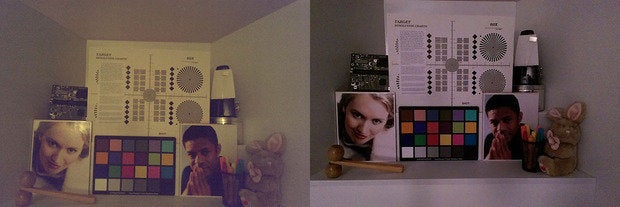
Photos taken in ample lighting with the first- and second-generation HTC
One were mostly indistinguishable, but while the photo looks great from
afar, that 4MP UltraPixel sensor still has its drawbacks. These aren’t
high resolution photos that you can zoom in on and crop. They’re great
for posting photos to Facebook and Instagram, and while the One takes
much better-looking photos than a lot of Android devices, its limited
resolution is a drawback at times.
 Florence Ion
Florence Ion
We can’t forget the new Selfie cam—that is, the HTC One’s 5MP,
wide-angle front-facing camera. I’d be fibbing if I didn’t admit that I
had tons of fun with this particular mode. Case in point:
Selfie mode offers a three-second countdown, so you can adequately
prepare yourself for your brief moment of narcissism. HTC also brought
back the Zoe camera and added the ability to record an indefinite amount
of video. There are tooltips to help you learn how to use the feature,
and you’ll find Zoe especially helpful when it comes to making short
Vine- or Instagram-worthy videos. Now you won’t have to launch a
separate app to capture the moment.
HTC successfully managed to cram a plethora of useful features into the
camera application without making it overwhelming for the user. The main
menu offers six options for taking photos, while the Settings button
lets you easily set the camera mode, exposure, ISO, and white balance.
There are also additional settings for cropping and setting the video
quality, and you can save your own custom camera modes for use in the
future. There are tons of modes for every situation, from a very fast
burst shot mode, multi-exposure action shots, slow-mo video, and
360-degree panoramas.
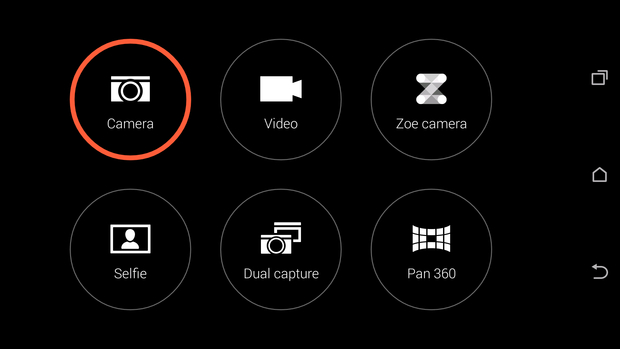
HTC’s “Sixth Sense”
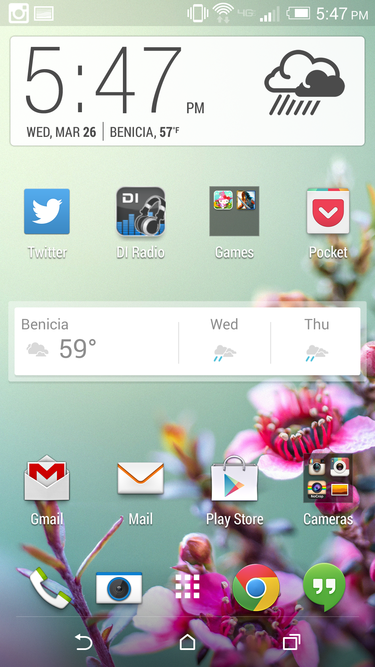
You can think of Sense 6 as a highly stylized version of stock Android.
It’s not gaudy like Samsung and LG’s own Android overlays, and it brings
a bit of finesse to the vanilla Android interface. HTC has kept the
most essential parts of Android on par with Google’s rendition, so as to
avoid scaring off die-hard Android fans.
HTC’s interface blends in more with the general Google design aesthetic,
so there’s less of a jarring transition between HTC’s apps and, say,
Google Now. Not to mention that you also have access to Android 4.4’s
new features, like the Location panel and wireless printing.

I’m still not a fan of Sense’s application drawer, however. HTC
incorporated an extra column of icons, but by default the apps are too
spaced-out, using up precious screen space. I’m also not particular to
the Quick Settings in the Notifications shade; the icons for each option
are too big, and at first glance it looks messy and crowded. But you
can rearrange the icons and eliminate the settings you don’t plan to
use.
Sense 6 is a bit more colorful, too, with the addition of themes. Though
you can only choose from four different ones at the moment, HTC hinted
that it’s considering opening up theming capabilities to its loyal
Android base. For now, all you can really customize is the wallpaper,
font size, and font style.

Gestures galore
Sometimes, gestures are a joke; a ploy on a manufacturer’s part to get
consumers to think that they can do more with their phones than tap at
it. HTC’s Motion Launch gestures are honestly useful, and I applaud the
company for making them a practical part of the user experience rather
than something that I immediately want to disable in the settings.
The gestures work well, for the most part. I did have trouble double
tapping the phone to wake it up after the screen had been turned off for
some time, but the side-to-side swipes worked almost every time.
Don’t blink (or you’ll miss BlinkFeed)
Apparently, HTC finally decided it would turn BlinkFeed into a
full-blown news and social network aggregator. I was not of fan of the
app on the first HTC One, but I’m slowly warming up to it now that HTC
has made it... well, useful.
Likely inspired by the death of Google Reader, now you can add any
content you want to BlinkFeed. Just swipe to the right to bring up the
menu, and type in what you’re looking for, whether it be a favorite yoga
instructor or version of Android. Your BlinkFeed will then begin to
aggregate content with that search term, and display it in its hub for
quick consumption. You can also subscribe to individual Twitter feeds
and YouTube channels.
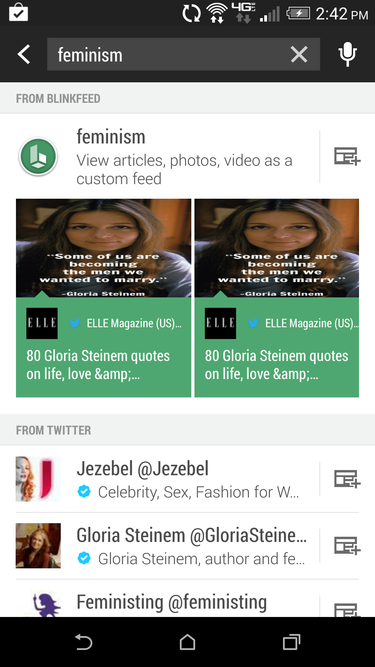
You can also use BlinkFeed to post to your various social networks, or
get updates from various apps. HTC has opened up the BlinkFeed API to
other developers, so expect more functionality to come to it in the
coming months.
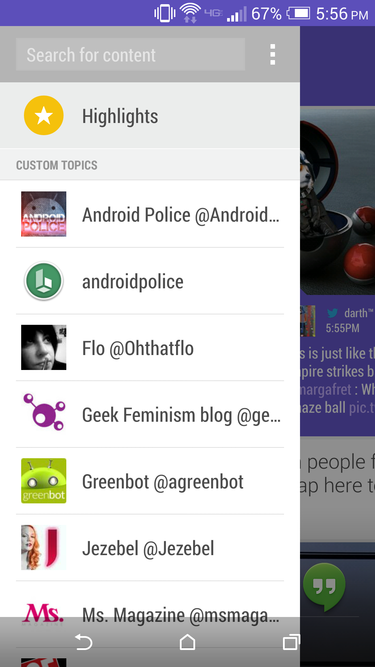
A phone worth waiting for
The second-generation HTC One has charmed us all. It features build
quality and industrial design a cut above all other Android phones; long
battery life; blazing fast performance; really nice interface
customizations; wonderful camera software; and terrific sound. But it
still lacks some features we love, like a high-resolution camera and
touchless voice commands. At least HTC offers this neat Dot case, which
displays the time and notifications through the cover like a Lite
Brite.
 Michael Homnick
Michael Homnick
That doesn’t mean that the One isn’t a total package. It comes standard
with a totally capable camera that can take good low-light photos—not to
mention, incredible selfies—a premium build, amplified volume
to aid in shower singing, extended battery life, and a simplistic
Android overlay that isn’t bogged down with bloatware (though your
carrier of choice may force some on you).
The HTC One (M8) is a winner, but we won’t know if it manages to put a
dent in HTC’s misfortunes until the end of the year, when we find out
how many units it’s managed to sell. The phones that will compete most
directly with the One will ship soon, but HTC certainly is off to a
strong start with what is currently the best Android phone you can buy.



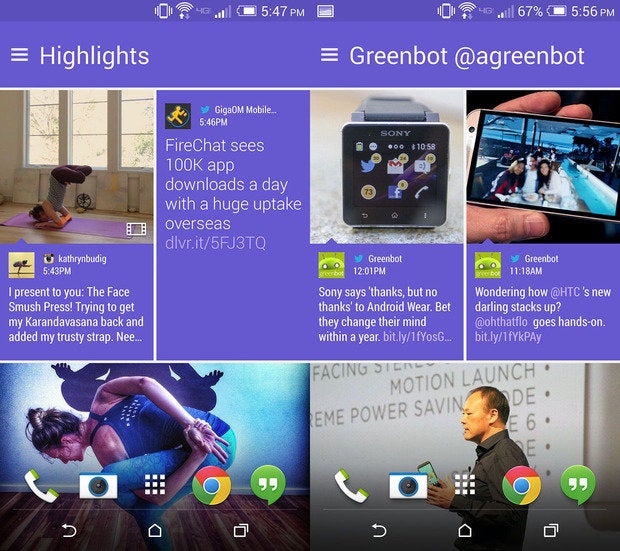
ليست هناك تعليقات:
إرسال تعليق